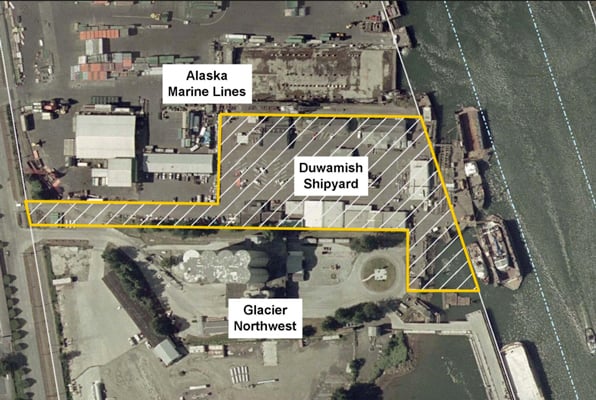The Duwamish Shipyard, located in Seattle, Washington, was one of the largest shipbuilding sites in the nation. It focused on repairing vessels and related equipment. Duwamish Shipyard used asbestos in numerous products, putting many workers at risk of developing mesothelioma and other illnesses.
If you or a loved one have been diagnosed with mesothelioma, asbestos-related lung cancer, or asbestosis, you may be eligible for substantial compensation. There is currently over $30 billion in asbestos trust funds set up for victims of asbestos-related diseases. Fill out our form to get a free Financial Compensation Packet. You’ll learn about the experienced mesothelioma lawyers in your area, how to get paid in 90 days, how to file a claim for the asbestos trust funds, and more.


FREE Financial Compensation Packet
- Info on law firms that will recover your HIGHEST COMPENSATION
- Learn how to get paid in 90 days
- File for your share of $30 billion in trust funds

Did Duwamish Shipyard Use Asbestos?
Duwamish Shipyard used asbestos in its ship maintenance and repair operations for decades. Shipbuilding and ship repair long used asbestos for its ability to insulate and fireproof.
Until regulations forced shipyards to stop using it, asbestos was heavily used in shipyards like Duwamish from about the 1930s to the 1970s.
Duwamish Shipyard History
The Duwamish Shipyard was established in May 1941 after it was acquired from King County.
- In the beginning, the primary function of the shipyard was the repair and maintenance of ships and ship-related equipment. The shipyard contained a graving dock and two dry docks.
- During the 1970s, Duwamish Shipyard expanded substantially, and the employee rate grew to around 500 workers.
- During this time, the shipyard took on shipbuilding but could not keep up with the demand. It eventually reverted to the repair and maintenance of vessels only.
- Over the years, Duwamish Shipyard’s productivity began to dwindle until it finally shut down permanently in 2007.
Duwamish was just one of several shipyards in the area to close in the 2000s. Duwamish and other industrial operations, like Lockheed Shipbuilding, left the Duwamish River contaminated with numerous substances, like PCBs and asbestos. Cleanup projects are being planned for the Duwamish Superfund Site.
How Did the Duwamish Shipyard Use Asbestos?
One of the primary uses of asbestos-containing products at Duwamish Shipyard was in refitting and overhauling hundreds of barges. This continued throughout the late 1970s when the Environmental Protection Agency (EPA) placed strict regulations on the use of asbestos at job sites, including shipyards.
The shipyard restored many vessels with asbestos-containing products. One such restoration on the Lightship No. 83 vessel contained excessive amounts of asbestos.
Additional asbestos was found in the following products and materials and Duwamish Shipyard:
- Boiler room parts
- Generator exhaust pipe insulation
- Steam drum insulation
- Feedwater heater insulation
- Steam piping insulation
- Gaskets
- Valves
Who Was Harmed By Asbestos at Duwamish Shipyard?
Anyone who worked at Duwamish during the years of asbestos use was at risk for exposure. Asbestos releases small fibers into the air that anyone in the area can inhale. Even workers who did not handle asbestos could have been exposed.
The workers at greatest risk handled asbestos materials. They cut into the materials, manipulated them, or removed and installed them. This caused the materials to release fibers right around the workers, who most likely inhaled them.
Duwamish Shipyard Cleanup
The Washington State Department of Ecology (DOE) created an agreement in 2010 with the shipyard to clean up the site.
Duwamish Shipyard accepted the agreement and took responsibility for the cleanup under the Model Toxics Control Act.
According to the DOE, the Duwamish Shipyard agreed to:
- Remedial Investigation (RI). The RI will collect data necessary to adequately characterize the contamination in soil, groundwater, stormwater, and sediments.
- Feasibility Study (FS). The FS will use the results of the RI to propose cleanup alternatives for the site.
The DOE states the cleanup and remediation of the site is still underway. Aside from asbestos, other toxic substances found at Duwamish Shipyard include arsenic, cadmium, chromium, copper, lead, zinc, and more.
Compensation for Former Duwamish Workers
There have never been any asbestos-related lawsuits filed against Duwamish Shipyard. This is because workers file cases against the asbestos manufacturers that provided asbestos to shipyards.
If you worked at Duwamish and were diagnosed with an asbestos illness, you could be entitled to compensation through a lawsuit. A mesothelioma lawyer can review your case and determine which companies are responsible for your illness.
Additional Help and Resources
If you’ve been injured by mesothelioma, asbestos-related lung cancer, or asbestosis, keep in mind that there is a good chance that you’ll qualify for considerable compensation. Don’t forget to fill out our form to get our free Financial Compensation Packet, filled with information on the experienced asbestos and mesothelioma attorneys in your area.

Paul Danziger
Reviewer and EditorPaul Danziger grew up in Houston, Texas and earned a law degree from Northwestern University School of Law in Chicago. For over 25 years years he has focused on representing mesothelioma cancer victims and others hurt by asbestos exposure. Paul and his law firm have represented thousands of people diagnosed with mesothelioma, asbestosis, and lung cancer, recovering significant compensation for injured clients. Every client is extremely important to Paul and he will take every call from clients who want to speak with him. Paul and his law firm handle mesothelioma cases throughout the United States.
References
- Washington Department of Ecology. (2020, February). Duwamish Shipyard.
Retrieved from: https://fortress.wa.gov/ecy/gsp/Sitepage.aspx?csid=54 - Hedley-White, J. and Milamed, D.R. (2008, September). Asbestos and Ship-Building: Fatal Consequences. Ulster Med. J. 77(3), 191-200.
Retrieved from: https://www.ncbi.nlm.nih.gov/pmc/articles/PMC2604477/ - U.S. Environmental Protection Agency. (2023, August 8). Asbestos Laws and Regulations.
Retrieved from: https://www.epa.gov/asbestos/asbestos-laws-and-regulations
